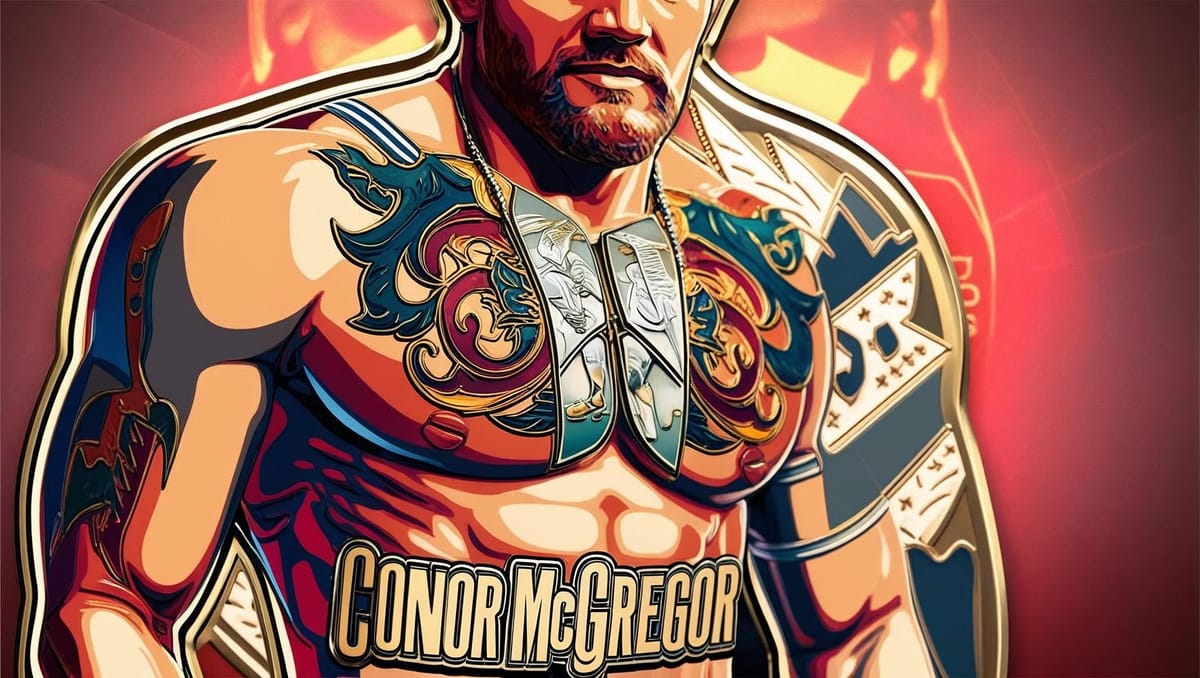Everything You Need to Know Before Buying McGregor’s Coin — It’s Either Moon or McTapout

On April 5, 2025, former UFC champion and global celebrity Conor McGregor made headlines by stepping into the cryptocurrency arena—not as an traders or ambassador, but as the face behind a new memecoin called “REAL.”
The launch has sparked a frenzy across social media, crypto forums, and trading communities. This isn’t just another celebrity endorsement—it’s a full-scale memecoin project developed in collaboration with Real World Gaming DAO, offering staking rewards and voting rights for holders.
I changed the FIGHT game.
— Conor McGregor (@TheNotoriousMMA) April 5, 2025
I changed the WHISKEY game.
I changed the STOUT game.
Now it’s time to change the CRYPTO game.
This is just the beginning.
This is $REAL @getrealtoken https://t.co/tdUyvqyZHZ#GetReal pic.twitter.com/imoAYwY8D1
While fans and retail traders scramble to grab a piece of the action, this event offers a critical learning moment for beginners, and everyday individuals who are being drawn into the world of investing by hype, celebrity influence, and the dream of fast profits.
This article will break down what “REAL” is all about, the psychology behind why people rush into memecoin investments, and how traders and first-time traders can avoid falling into emotional traps that often lead to regretful decisions.
What Is the “REAL” Memecoin?
“REAL” is a newly launched cryptocurrency token powered by a decentralized autonomous organization (DAO) known as Real World Gaming. Unlike traditional token launches that may favor insiders, bots, or early whales, McGregor’s memecoin was released via a sealed-bid auction. This model was designed to promote fairness and transparency. Anyone who wanted to participate had to submit a bid between April 5 and April 6, with allocations based on the bid size and total demand.
In McGregor’s own words, “This is about transparency — we are showing the world how it is done with integrity.” With that statement, McGregor positioned the project as more than just a quick cash grab or a promotional stunt. However, regardless of intentions, a celebrity-backed memecoin is still a high-risk financial instrument—especially for beginners.
The token offers community features such as:
- Staking rewards
- Voting rights on future developments
- Ties to decentralized gaming ecosystems
In practice, it appears to follow in the footsteps of other celebrity coins like TRUMP (endorsed by Donald Trump) and similar tokens promoted by influencers and entertainers.
The Rise of Celebrity Coins: A Double-Edged Sword
In the past, celebrities endorsed physical products—perfumes, clothing lines, and fitness supplements. Today, many are entering the world of Web3 and decentralized finance by attaching their name and brand to crypto tokens, NFTs, or DeFi platforms. This marks a significant shift in how public figures monetize their fame in a digitized world.
On one hand, this can help bring mainstream attention to blockchain technology. On the other, it opens the door to serious psychological manipulation, especially when audiences lack financial education. Most traders in memecoins are not seasoned analysts or professional traders. Many are young, first-time traders driven by social media buzz and the fear of missing out.
This is why the psychology of investing becomes critically important.
The Psychology Behind Memecoin Investing
For beginner traders, the most dangerous enemy in financial markets isn’t volatility—it’s emotion. Memecoins thrive on emotion-driven decisions. They’re not built on strong business models, long-term roadmaps, or sustainable fundamentals. Instead, their price movement depends on social proof, online hype, and virality.
Understanding the psychological traps that drive memecoin mania is the first step toward building real investment discipline.
1. FOMO (Fear of Missing Out)
One of the most common psychological forces in crypto investing is FOMO. When a coin like “REAL” gains momentum online, people begin to feel like they are being left behind. They see screenshots of massive gains, viral tweets, and a celebrity’s face associated with the coin, and they feel pressure to act fast—without proper research.
This is FOMO in action. It creates a false sense of urgency, tricking the brain into believing that now is the only time to profit, and that waiting means you’ll miss out forever.
In reality, FOMO leads to rushed decisions, poor entry points, and panic selling when things go wrong. Long-term investing is never about rushing in—it’s about strategic planning.
2. The Halo Effect
The halo effect is a cognitive bias where our impression of one aspect of a person or product influences our opinion of everything else related to it. In the case of Conor McGregor, fans admire his discipline, charisma, and fighting skills. When he launches a memecoin, those positive traits transfer to the perception of the coin—even if McGregor has no proven expertise in crypto economics.
This leads to misplaced trust. Traders believe the coin is “legit” simply because they trust the person behind it, not because they understand the project’s inner workings.
The solution is simple: evaluate the product, not the promoter. Every financial asset must be judged on its own merits.
3. Herd Mentality
Humans are social creatures. We tend to follow what others are doing, especially in uncertain environments. When we see a large group of people rushing into a new coin, our instinct is to follow the crowd. We assume that the group must know something we don’t.
This is known as herd mentality. In investing, it leads to bubbles and irrational behavior. Herds don’t think—they react. And when the sentiment turns negative, the same herd that pushed the price up can drive it back down just as quickly.
To avoid herd mentality, traders must learn independent thinking. Ask yourself: “Would I invest in this if nobody else was talking about it?” If the answer is no, you're not investing. You're chasing.
4. Dopamine Addiction and the Slot Machine Effect
Memecoins, especially those that move quickly in price, trigger chemical reactions in the brain. When you see your portfolio spike 100 percent in a day, your brain releases dopamine—a neurotransmitter associated with pleasure and reward. This creates a feedback loop similar to what slot machines and gambling apps rely on.
The danger here is emotional dependency. Traders begin to crave the thrill, and their focus shifts from wealth building to chasing short-term highs. What begins as investing slowly becomes gambling, and the traders loses control.
Understanding this neurological response is crucial. If your investment decisions are driven by the need to “feel something,” you’re no longer acting rationally.
5. Confirmation Bias
Once we invest in a project—especially one tied to a celebrity we admire—we begin to seek out only the information that confirms our decision. We ignore red flags, dismiss warnings, and surround ourselves with echo chambers that reinforce our beliefs.
This is called confirmation bias. It prevents growth and reflection, and it amplifies risk. Smart traders constantly challenge their assumptions. They ask: “What could go wrong?” and “What evidence do I have against this idea?”
Traders must learn to be skeptical thinkers. In a world where viral content spreads faster than facts, skepticism is a form of protection.
Case Study: The Rise and Fall of Past Celebrity Coins
To fully grasp the risks, it’s useful to look at historical patterns. Several celebrity-backed coins and NFT projects have launched with great excitement, only to crash within weeks.
In some cases, the celebrities involved distanced themselves from the projects after a drop in value. In other instances, legal action was taken due to a lack of transparency or misleading promotions. The U.S. Securities and Exchange Commission (SEC) has previously fined celebrities like Kim Kardashian for improperly promoting crypto assets.
What this shows is that celebrity involvement does not guarantee legitimacy, safety, or profitability. If anything, it should signal the need for extra scrutiny.
What New Traders Should Do Instead
Given all the psychological traps and historical examples, what is the right approach for beginners who are interested in crypto but want to protect themselves?
Here are five clear strategies:
1. Prioritize Education Over Hype
Before investing in anything, ask yourself: Do I understand what this token does, how it earns value, who is behind it, and what risks it involves? If the answer is no, start with research—not money.
There are countless free resources, beginner courses, and communities that teach crypto fundamentals. Treat your financial education as seriously as you would a university subject.
2. Set Clear Investment Rules
Develop a personal investment framework. For example:
- Never invest more than 5 percent of your savings into high-risk assets
- Never invest based on emotion or peer pressure
- Always set a stop-loss or exit plan in advance
Having a rulebook gives you structure and reduces impulse decisions.
3. Understand the Difference Between Trading and Investing
Trading is about short-term speculation. Investing is about long-term growth. Memecoins like “REAL” often attract traders, not traders. If your goal is to build wealth over time, focus on assets with strong fundamentals, real-world use cases, and sustainable development teams.
Understand what game you are playing—and play it well.
4. Track Your Emotions
Every investment decision is an emotional one. Start keeping a journal of your trades, including what you felt before, during, and after making them. Over time, patterns will emerge. You’ll begin to recognize when emotion is influencing your actions.
Emotional self-awareness is one of the most powerful tools any traders can develop.
5. Focus on Long-Term Mental Wealth
Your mental state is just as important as your portfolio. Constant checking, panic buying, and mood swings from price fluctuations can affect your academic performance, relationships, and mental health.
Investing should serve your life—not consume it. Build a system that lets you grow your wealth without compromising your peace of mind.
Conclusion: McGregor’s Memecoin Is a Lesson, Not a Blueprint
The launch of “REAL” marks an important cultural moment. It shows how deeply crypto has penetrated mainstream consciousness. But for traders and new traders, the real value of this event isn’t the potential profit—it’s the opportunity to learn.
Memecoins can be fun, social, and even profitable in the short term. But they are not substitutes for solid financial planning, deep research, or disciplined investing. Just as McGregor trained for years to become a world-class fighter, financial success requires training, patience, and control.
Don’t let hype train your mind. Train your mind so that you are never controlled by hype.
